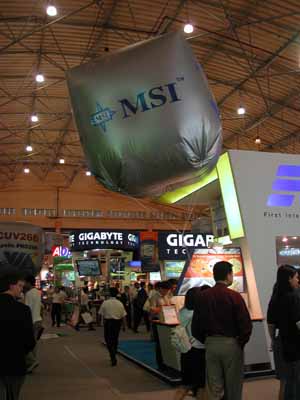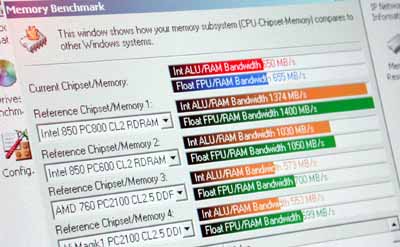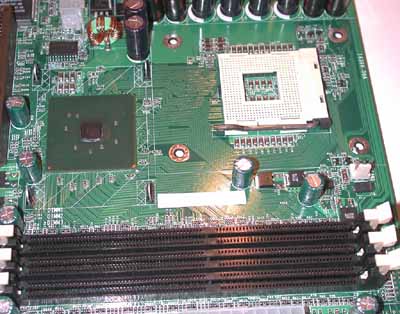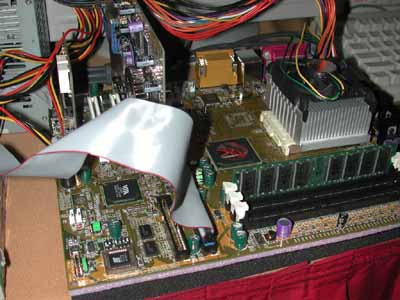
Original Link: https://www.anandtech.com/show/782
Computex 2001 - Day 2
by Anand Shimpi & Mike Andrawes on June 5, 2001 11:33 AM EST- Posted in
- Trade Shows
We've almost got all of the information we need to completely cover the show and it couldn't be at any better of a time since we leave the island of Taiwan later today.
Over the next few days we will bring our coverage to a close, summarizing all of the new technology and products you will be able to see in the near future.
A Peaceful Resolution
Computex 2001 kicked off for its second day today with yet another round of the Intel/VIA fiasco. For those of you that didn’t catch our original coverage, Intel was forcing motherboard manufacturers to pull down balloons advertising the VIA brand and products from above their booths.

Today we saw the return of the elusive VIA balloons however they were tied to the hands of some unlucky individuals who had the job of standing around displaying balloons all day.

Eventually the balloons were restored to the rightful locations (in many cases) after VIA representatives contacted many of the Presidents and CEOs at some of the larger motherboard manufacturers.
More on nForce
We met with NVIDIA today at Computex to address some of the questions we had about nForce after the official launch.
The big news actually seems to be the real reason that NVIDIA is not producing a Pentium III version of the nForce is because Intel won’t give them a license for the GTL+ bus used on the Pentium III. Of course our next question was how they were able to produce the chipset for the XBOX, which uses a Pentium III processor, without a GTL+ license from Intel. Well it turns out that Microsoft is the one with the GTL+ license for the XBOX and by virtue of being picked by Microsoft, NVIDIA was able to develop a GTL+ chipset. That license, however, is only for the XBOX and NVIDIA will not be able to take advantage of it for a desktop chipset. Why wouldn’t Intel want such an advanced chipset powering their processors? Remember that the chipset market is a big part of Intel’s business model – maybe they’re just as scared of NVIDIA taking over the whole market as the rest of the chipset makers out there.
As far as future chipset plans go, NVIDIA wouldn’t give us much info, but did state that they’d follow the same model they took with graphics, taking a current platform and extend it to higher and lower end market segments. Based on their success in the graphics market, it looks like they could very well be the top dog in the chipset market in a relatively short period of time. Of course, they got there by producing high quality products and staying a step ahead of the competition. If they can do the same in the chipset market, they very well could dominate.
We also learned a bit more about DASP, but not too much because much of the technology is still patent pending. Once the patent is granted, they will release a lot more detail. What they did tell us, however, is that it is basically a cache on the north bridge that does function much like a processor’s hardware prefetch. The nForce IGP uses an 8-way set associative cache and can perform 8-way prefetching. Unfortunately, size of the TLB and cache are not being disclosed at this time.
NVIDIA confirmed that the sound in the standard MCP is indeed identical that of the MCP-D, with the exception of Dolby Digital Encoding. It turns out that the two chips are probably identical in design; it’s just a matter of paying extra for the Dolby license to gain the AC-3 encoding functionality. This is much like the situation with the GeForce and Quadro GPU lines, which are also identical internally with some features simply disabled for the GeForce line. Information has been on the web for quite some time about how to convert a GeForce into a Quadro, and it’s very possible that something similar will be possible with the MCP and MCP-D.
We originally speculated that the TwinBank architecture would probably be able to support a total of 4 DIMM slots if carefully designed. NVIDIA confirmed that in our meeting today, although it’s apparently quite difficult to design a 4 DDR DIMM slot board according to the motherboard manufacturers due to loading issues.
NVIDIA remains tight lipped on pricing since they try to stay away from that side of things, instead leaving it up to the actual board manufacturers. Fortunately, a couple of motherboard manufacturers were being a bit more forthcoming. One suggested 30% less than the cost of a current DDR motherboard plus a GeForce2 MX card. Another seemed to be indicated a price of under $200, probably in the $150-175 range, exactly the price range that many AMD 760 based motherboards are selling in right now. Of course, by the time nForce is released in September, it’s very possible that prices on current products will have dropped noticeably.
As we hinted out with our initial coverage, NVIDIA’s StreamThru technology is really a feature of Hyper-Transport where a virtual channel is created along the bus to guarantee the availability of bandwidth for isochronous data. It turns out that StreamThru is a bit more in that it includes an isochronous-capable Ethernet controller. Incidentally, it turns out that the MCP Ethernet controller was not handled in house, but they wouldn’t disclose exactly who did design it. It also turns out that the dual master Ultra ATA 100 controller in the MCP may also be capable of taking advantage of a StreamThru-like virtual channel when transferring isochronous data from the hard drive.
i845 (Brookdale) DDR
Nearly every motherboard manufacturer we talked to had two i845 motherboards at the show: a PC133 i845 on display, and a DDR i845 underneath the table that Intel wouldn’t allow them to show.
In our Day 1 coverage we explained why Intel isn’t allowed to promote the DDR
i845 platform until
Another thing we were able to do is spend some time benchmarking an i845 with regular PC133 SDRAM. The performance tests we were able to run were limited to one or two benchmarks, but the results we saw were pretty interesting.

In our most recent AMD 760MP and Athlon MP Review we provided a good amount of memory bandwidth figures produced by SiSoft Sandra 2001’s memory benchmark.


The important thing here isn’t to look at the standings, but the percent utilization of the memory bus. For example, in the FP STREAM test, the Pentium 4 1.5GHz offers 1400MB/s of memory bandwidth yet the chipset can deliver a theoretical maximum of 3.2GB/s of memory bandwidth (~3200MB/s). This indicates that around 44% of the memory bandwidth is being utilized.
In the case of the single processor Athlon MP, only 36% of its DDR266 memory bandwidth is being utilized. You can already see that the Pentium 4’s FSB is able to take advantage of higher bandwidth memory technologies much more effectively than the Athlon’s FSB (400MHz data clock vs 266MHz data clock).
The Pentium 4 1.5GHz on a PC133 i845 platform manages to use over 61% of its peak theoretical memory bandwidth. While in the first two cases memory bandwidth wasn’t the limiting performance factor, in the case of the i845 the Pentium 4 comes very close to saturating the PC133 memory bus.
VIA’s P4X266 Benchmarked
At VIA’s C3 Ezra press-conference there was a little gem that stole the show from the C3 processor; VIA’s DDR Pentium 4 chipset was up and running.
After only two silicon revisions, the P4X266 is up and running and according to VIA’s benchmarks, the platform is actually outperforming the i850. VIA ran 3DMark 2001 on their P4X266 with a GeForce2 GTS at 1600 x 1200 x 32 and ran the same benchmark on a similarly configured i850 setup (ASUS P4T Motherboard) and came out with two scores: 1391 for the i850 and 1484 for the P4X266. Assuming that VIA didn’t cripple the i850 system on purpose this gives the P4X266, in its current very early beta state, a 7% performance advantage over the i850.
This information directly conflicts with what motherboard manufacturers told us about i845 (Brookdale) DDR being only 15% faster than i845 SDR and still 10% slower than i850. It is very possible that Brookdale isn’t performing up to spec this early or even more likely is that motherboard manufacturers are currently only running at DDR200 speeds in order to remain synchronous with the FSB on the Pentium 4.
VIA shows muscle but not dual processors
As yet another day at Computex came to an end we heard another interesting story from a motherboard manufacturer. It seems like Intel isn’t the only one that knows how to play hard ball when it comes to manipulating motherboard manufacturers. More than one manufacturer reported that VIA offered help in improving the performance of KT266 based solutions if the motherboard makers agreed not to include the SiS 735 chipset in their product lines.
The type of help offered by VIA is in the form of a special performance BIOS as well as updated IDE drivers that are apparently not available as of yet.
There have been rumors of VIA producing a cost effective competitor to the AMD 760MP chipset. And while we have received some confirmation that there have been talks about producing such a chipset, it is currently very low on VIA’s priority list. If a DP Athlon chipset project were to ever surface it would do so around Q2-2002 at earliest.
VIA still is far from being a high-end workstation/server chipset manufacturer. Even AMD is having trouble enough breaking into those markets.









